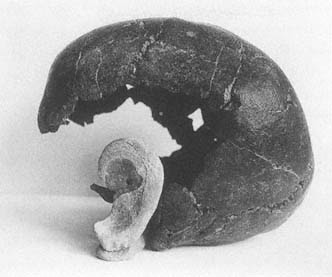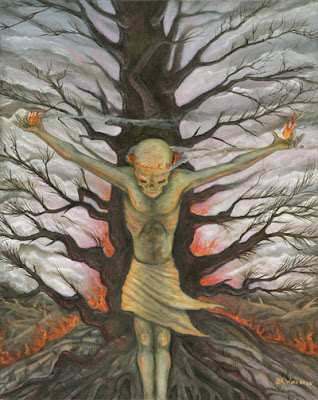 Archaeologists in the Burnt City have discovered what appears to be an ancient prosthetic eye. What makes this discovery exceptionally awesome is the striking description of how the owner and her false eye would have appeared while she was still alive and blinking:
Archaeologists in the Burnt City have discovered what appears to be an ancient prosthetic eye. What makes this discovery exceptionally awesome is the striking description of how the owner and her false eye would have appeared while she was still alive and blinking:[The eye] has a hemispherical form and a diameter of just over 2.5 cm (1 inch). It consists of very light material, probably bitumen paste. The surface of the artificial eye is covered with a thin layer of gold, engraved with a central circle (representing the iris) and gold lines patterned like sun rays. The female remains found with the artificial eye was 1.82 m tall (6 feet), much taller than ordinary women of her time. On both sides of the eye are drilled tiny holes, through which a golden thread could hold the eyeball in place. Since microscopic research has shown that the eye socket showed clear imprints of the golden thread, the eyeball must have been worn during her lifetime. The woman’s skeleton has been dated to between 2900 and 2800 BCE.
So she was an extraordinarily tall woman walking around wearing an engraved golden eye patterned with rays like a tiny sun. What an awesome sight that must have been.

 The earliest evidence of ancient dentistry we have is an amazingly detailed dental work on a mummy from ancient Egypt that archaeologists have dated to 2000 BCE. The work shows intricate gold work around the teeth. This mummy was found with two donor teeth that had holes drilled into them. Wires were strung through the holes and then around the neighboring teeth.
The earliest evidence of ancient dentistry we have is an amazingly detailed dental work on a mummy from ancient Egypt that archaeologists have dated to 2000 BCE. The work shows intricate gold work around the teeth. This mummy was found with two donor teeth that had holes drilled into them. Wires were strung through the holes and then around the neighboring teeth.
Neolithic skull and its prosthetic seashell ear, found at Roque d’Aille.
It’s not even the fact that the skull, upon examination, turned out to be trepanned. It had been carved open, apparently, with the aid of a rough flint—a primitive crown saw—and the brain had been operated on for an estimated period of three hours. The whole intervention had left a cicatrice nine centimeters long. No, it’s neither the black skull nor the jagged scar that runs like some kind of virulent root about one side of the skull plate that so fascinates us today, but the ear, the artificial ear, that once locked into the left side of that hollow, black receptacle. Carved from a seashell, the spondylus Graederopus, its artisan had used the shell’s thick hinge to replicate the earlobe and its shallow vault to imitate the concavity of the ear’s outer whorl. Ironically enough, the external ear is also known, anatomically, as a concha . We’re left examining, finally, a delicate prosthesis, one of the earliest artificial members ever discovered. It measures sixty-five by thirty-six millimeters: approximately the measurements of an average human ear. Paleopathologists have determined that the subject of this conchate device was almost certainly a woman, a young woman. Furthermore, these specialists are convinced that the woman had not only survived that harrowing “open brain” operation, but had gone on to live for many years, for they’ve detected on the underside of that artificial organ tiny microscopic traces of patina due, unquestionably, to wear. Was this the result of simple abrasion (the mechanical rub of one surface against another) or the deliberate toying, on the young woman’s part, with her curious appendage? Had she fondled its slick underside so often that specialists—peering through electromagnetic microscopes five thousand years later—would pick up traces of the infinitesimal luster left there by the play of her fingertips? By the roll of her thumb and forefinger over its nacreous lip?….More in University of California Digital LIbrary
 |
| Greville Chester toe |
 |
| Tabaketenmut toe |
Two false mummy big toes may have been the world’s earliest functional prosthetics, according to a study which has successfully tested replicas on volunteers. Discovered in the necropolis of Thebe near present-day Luxor, the two artificial toes — the so-called Greville Chester toe housed in the British Museum and the Tabaketenmut toe at the Egyptian Museum in Cairo –- date back to before 600 B.C. They predate by a few hundred years, a Roman leg made out of bronze and wood in around 300 B.C, known as the Capua leg. The leg was destroyed by Second World War bombings.
Acquired by the British museum in 1881, the Greville Chester toe comes in the shape of the right big toe and a portion of the right foot. It was made from cartonnage — a type of papier mâché made of linen, soaked with animal glue and coated with tinted plaster. “It is skilfully crafted and at one time carried a false nail,” Jacqueline Finch, a researcher at the University of Manchester’s KNH Centre for Biomedical Egyptology, wrote in the British medical journal The Lancet.
The other false toe, now in Cairo’s Egyptian Museum, was found attached on the right toe of a mummy identified as Tabaketenmut. A priest’s daughter who lived sometime between 950 and 710 B.C., Tabaketenmut might have lost her toe following gangrene triggered by diabetes. Her false big toe was a three part wood and leather artifact which also included a hinge, possibly intended to mimic the flexibility of the joints.
Both artificial toes had holes for lacings to either attach the toes onto the foot or fasten it onto a sock or sandal. However, finding a false toe fastened onto an amputee mummy toe doesn’t necessarly prove the artifact was used as a prothesis. “There is plenty of evidence from mummified remains to show that the ancient Egyptian embalmers made every attempt to reinstate the completeness of the physical body before burial,” Finch said. Indeed, missing limbs, eyes, noses, limbs and even genitals were often added to help a person properly enter the afterlife.
But while the limbs added by the embalmers were poor imitations, the Greville Chester and the Tabaketenmut toes bore distinctive signs of wear. Moreover, they appeared “far more sophisticated in both design and appearance,” said Finch. In order to find out whether the false toes were added for cosmetic purposes or used to help in walking, the researcher created two reproductions modelled as the Greville toe and the Tabaketenmut digit. “The big toe is thought to carry some 40 percent of the bodyweight and is responsible for forward propulsion, although those without it can adapt well,” Finch wrote. “My own research used two volunteers with similar amputation sites and suggested that replicas of both ancient Egyptian false toes performed extremely well,” she said. Wearing the toes with replica Egyptian sandals, the volunteers found the wooden Tabaketenmut digit to be especially comfortable. In particular, one of the volunteers was able to walk extremely well with both artificial toes. “Perhaps now attribution for the first glimmers of prosthetic medicine should be firmly laid at the feet of the ancient Egyptians,” Finch said.
And about Thephination I have dealt some years ago:

 Trephination is a medical intervention in which a hole is drilled or scraped into the human skull, exposing the dura mater in order to treat health problems related to intracranial diseases. Trepanation is perhaps the oldest surgical procedure for which there is forensic evidence, and in some areas may have been quite widespread. Out of 120 prehistoric skulls found at one burial site in France dated to 6500 BC, 40 had trepanation holes.
Trephination is a medical intervention in which a hole is drilled or scraped into the human skull, exposing the dura mater in order to treat health problems related to intracranial diseases. Trepanation is perhaps the oldest surgical procedure for which there is forensic evidence, and in some areas may have been quite widespread. Out of 120 prehistoric skulls found at one burial site in France dated to 6500 BC, 40 had trepanation holes.

























































.jpg)



